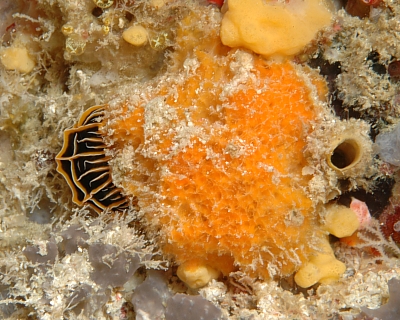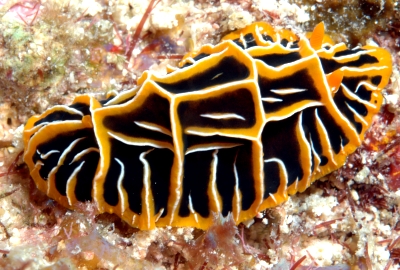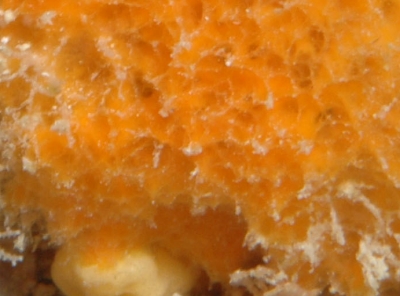Reticulidia halgerda from Fiji
May 24, 2006
From: Leanne & David Atkinson


Dear Bill,
On a recent trip to Fiji we came across this spectacular nudibranch. We have been to the same area 5 times before, always in April when the water is 29 degrees celcius and have never seen this nudibranch before. We've identified it from the Sea Slug Forum Fact Sheets as Reticulidia halgerda. We found it in a little cave/hollow on an orange sponge (in the first shot) and wondered if this was its food. There doesn't seem to be any information on its food in the fact sheet. We moved it to get a better picture to identify it. The hollow was so small that we couldn't fit our subal housing in to get a closeup shot.
Locality: Gotham City, near Mana Island, Mamanuca Islands, 20metres, South West Fiji, Pacific, 25 April 2006, Tropical Coral Reef Bommie. Length: approximately 20mm. Photographer: Leanne & David Atkinson.
The local dive guides say that nudibranchs are more common in their area later in the year when the water is cooler. The water temperature drops later in the year to 26 degrees celcius. We wondered if people could include water temperature in their details if they know it since this may be important information re the environmental conditions required for some species. Even tropical areas have fluctuations in their water temperature that may affect nudibranch behaviour.
Thanks,
Leanne & David Atkinson
atk@hunterlink.net.au
Atkinson, L. & D., 2006 (May 24) Reticulidia halgerda from Fiji. [Message in] Sea Slug Forum. Australian Museum, Sydney. Available from http://www.seaslugforum.net/find/16668
Dear Leanne & David,
This association with an orange sponge is very interesting - especially since your clear photo should enable us to identify the sponge. The only information we have on its feeding is a photo I was sent from Vanuatu by Ian Knight in 1984, which showed an encrusting orange sponge. When David Brunckhorst was working on these animals he had the sponge in the photo tentatively identified as a species of Verongia [Aplysinidae, Verongida], so your photo could well be another record of it on the same orange sponge.
Concerning water temps, I am happy for them to be included in data. 'Seasons' in the sea are quite complex. As you say, even in the tropics there is a fluctuation in temperature during the year, and there are also definite cyclical presences and absences of species during the year. Sometimes water temperature seems to be involved, but other times it seems changes in salinity brought about the huge influx of freshwater during the rainy season may be the trigger to particular biological events. We still have much to learn, and every little bit helps.
Best wishes,
Bill Rudman
Related messages
-
Re: Reticulidia halgerda from the Philippines
From: Paul Bourdin, November 18, 2009 -
Reticulidia halgerda from the Philippines
From: Mike Krampf, April 16, 2007 -
Reticulidia halgerda from Fiji
From: Mary Jane Adams, July 10, 2003 -
Reticulidia halgerda from the Solomons
From: Bruce Potter, September 14, 2001 -
Reticulidia halgerda & R. fungia togetherter
From: Mary Jane Adams, February 4, 2001 -
Reticulidia halgerda from the Solomon Islands
From: Mary Jane Adams, February 4, 2001 -
Reticulidia halgerda & R. fungia
From: Bill Rudman, November 28, 1999 -
Re: Decorated Phyllidia
From: Dr. A.D.Wright, March 25, 1998 -
Re: Decorated Phyllidia
From: Dr. A.D.Wright, March 23, 1998 -
Decorated Phyllidia
From: Dr. A.D.Wright, March 20, 1998
